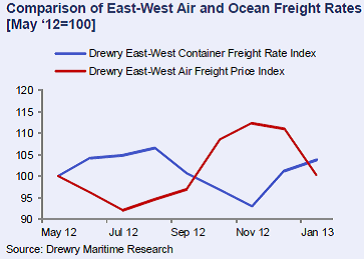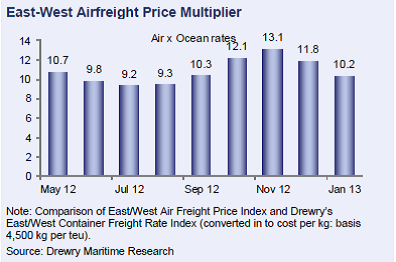Opposite Movements for Sea and Air Rates
Ocean and airfreight rates moved in opposite directions in January, according to Drewry’s monthly Sea and Air Shipper Insight.
Ocean shippers moving cargo on the key East-West trades continued to see marginal increases for spot cargo in January due to a combination of a seasonal volume boost prior to Chinese New Year and capacity cutbacks in the form of blank voyages.
Drewry’s East-West Freight Rate Index, a weighted average of container rates across Asia-Europe, transpacific and transatlantic trade routes, rose by 2.6% in January to reach its highest level since August of last year.
In contrast, airfreight rates fell sharply in January as the trade adjusted to post-peak-season traffic volumes. Drewry’s East-West Air Freight Price Index tumbled by 10.5 points from December, the largest monthly decline in the index since its inception in May 2012.
The air index was weighed down by weaker pricing on Asia-origin trades to both North America and Europe as well as falling eastbound transatlantic rates.
Airfreight Price Multiplier down a further 1.6 points to 10.2. The multiplier measures the relationship between the cost of shipping by air relative to sea on East-West trades.
“Airlines reported stronger demand in early February, which is likely to have lifted rates, but this momentum will have stalled through the remainder of the month with the onset of the Asian holiday season,” said Simon Heaney, research manager at Drewry.
Drewry expects East-West ocean rates to weaken post-Lunar New Year season, particularly as a number of suspended Asia-Europe services are set to return and reduce average ship utilization.
www.drewry.co.uk
















